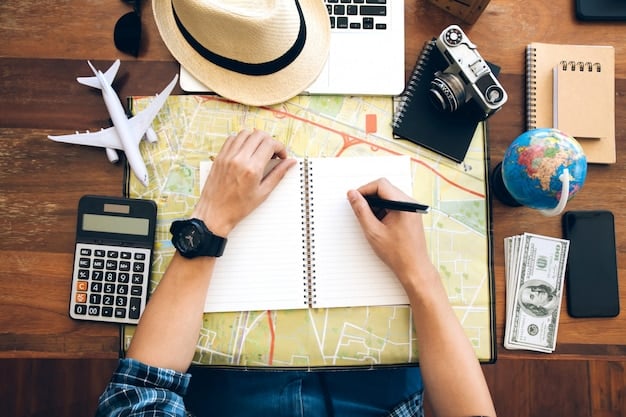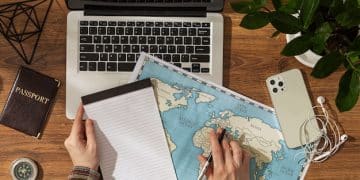3 Months to Departure: Your Stress-Free International Travel Guide

Planning international travel can be overwhelming, but a systematic three-month approach ensures a seamless experience, encompassing everything from crucial passport checks to financial preparation, health considerations, and meticulous packing strategies for a stress-free departure.
Embarking on an international adventure promises excitement, new cultures, and unforgettable memories. However, the path to a truly fulfilling journey often begins long before you step on the plane, requiring meticulous planning. This guide, “3 Months to Departure: Your Step-by-Step Guide to Stress-Free International Travel Planning,” will equip you with a comprehensive, actionable timeline to navigate the complexities of global travel, ensuring peace of mind from conception to takeoff.
The Three-Month Countdown: Laying the Foundation
The journey to an effortlessly smooth international trip truly begins about 90 days out. This initial phase is all about establishing a solid groundwork, addressing the big-picture items that can often become major headaches if left to the last minute. Think of it as building the skeleton of your travel plans.
During this period, your primary focus should be on defining the core elements of your trip. This includes selecting your destination, refining your travel dates, and establishing a realistic budget. These decisions will govern virtually every subsequent planning step. A clear vision at this stage prevents countless reworks and potential financial pitfalls later on.
Destination and Dates: The Cornerstones
Choosing where and when to go is more than just picking a spot on a map; it involves a deeper dive into logistics and personal preferences. Researching potential destinations based on your interests—be it historical sites, natural wonders, or culinary experiences—is paramount. Concurrently, consider the seasonality of your chosen location. Are you aiming for peak tourist season, or perhaps a more tranquil shoulder season? Each has its own implications for cost, crowds, and weather.
- Research Destinations: Explore cultures, attractions, and local customs.
- Check Seasonal Weather: Understand the best time to visit for your activities.
- Consider Major Events: Avoid or embrace festivals, holidays, or local celebrations.
Regarding dates, flexibility can be your best friend. Even shifting your departure or return by a day or two can sometimes yield significant savings on flights and accommodation. Tools that show pricing fluctuations over a calendar month are incredibly useful here. This also allows ample time for securing necessary visas and ensuring your passport remains valid.
Budgeting Basics: Financial Blueprinting
Creating a detailed budget at the three-month mark is critical. It’s not just about setting an arbitrary number, but rather breaking down expected costs into categories. This proactive approach helps in allocating funds appropriately and identifying potential areas for savings. Travel is an investment, and like any investment, it benefits from careful financial stewardship.
- Estimate Flight Costs: Research average prices for your chosen route.
- Project Accommodation Expenses: Factor in hotels, hostels, or rental properties.
- Anticipate Daily Spending: Account for food, transport, activities, and souvenirs.
Don’t forget to include a buffer for unexpected expenses. Life on the road, especially internationally, can throw curveballs. A contingency fund can be the difference between a minor hiccup and a major setback. This foundational planning prevents financial stress and allows for a more relaxed and enjoyable trip when the time comes.
Two Months Out: Securing the Essentials and Health Check
With your destination and dates solidified, the two-month mark shifts focus to locking down the non-negotiables: flights, accommodation, and crucially, all necessary documentation and health preparations. This phase moves from broad strokes to precise bookings and vital administrative tasks, ensuring you won’t be scrambling for last-minute approvals or forgotten vaccinations.
Flights and Accommodation: Booking Smart
By now, you should be ready to purchase your flights and secure your lodging. This is often the largest financial commitment of your trip, so careful consideration and comparison shopping are key. Utilizing incognito browsing mode or VPNs can sometimes help in finding better deals, as travel sites occasionally track your browsing history to adjust pricing.
- Book Flights: Aim for direct flights if possible to minimize connection risks.
- Secure Accommodation: Read reviews, check locations, and understand cancellation policies.
- Consider Travel Insurance: A wise investment, especially for international trips, to cover unforeseen circumstances like cancellations, medical emergencies, or lost luggage.
Paying attention to the details of your flight booking, such as baggage allowance and seat selection, can prevent hidden fees or uncomfortable journeys. For accommodations, verify accessibility, Wi-Fi availability, and check-in/check-out procedures. Early booking often provides a wider selection and better rates, giving you peace of mind.
Passport and Visa Protocol: Your Green Light Abroad
This is arguably the most critical step. Without a valid passport and the correct visas, your trip simply won’t happen. Checking your passport’s expiration date is paramount; many countries require it to be valid for at least six months beyond your planned return date. Initiating passport renewals can take several weeks, so do not delay.
- Verify Passport Validity: Ensure it meets the six-month rule.
- Research Visa Requirements: Determine if your nationality needs a visa for your destination.
- Apply for Visas: Begin the application process early, allowing ample processing time.
Visa applications can be complex, requiring various documents, photographs, and sometimes interviews. Start this process as soon as you have your flight and accommodation details confirmed. Some countries offer electronic visas (e-visas) which simplify the process, but always double-check official government websites for the most accurate and up-to-date information.

Health and Wellness: Prioritizing Your Well-being
International travel can expose you to different environmental and health challenges. Consulting with your doctor or a travel clinic two months before departure allows sufficient time for necessary vaccinations to take effect. They can also advise on any recommended medications for your destination, such as anti-malarials or altitude sickness pills.
- Consult Your Doctor: Discuss destination-specific health risks and vaccinations.
- Check CDC/WHO Guidelines: Stay informed about health advisories for your region.
- Pack a Basic Medical Kit: Include essentials like pain relievers, band-aids, and antiseptics.
Beyond vaccinations, consider how existing medical conditions might be managed while abroad. Prepare a list of your medications, including their generic names, and a letter from your doctor if carrying controlled substances. Understanding the local healthcare system and having travel insurance with robust medical coverage is also a crucial safety net for any unexpected health issues.
One Month to Go: The Practicalities and Last-Minute Checks
As the countdown shrinks to 30 days, the focus shifts to practical arrangements and meticulous double-checking. This is the stage where you consolidate your bookings, organize your finances for international use, and start thinking about the logistics of your actual journey. It’s also a good time to confirm earlier arrangements and address any lingering uncertainties.
Financial Preparedness: Money Matters Abroad
Ensuring your funds are accessible and secure while traveling internationally is paramount. Inform your banks and credit card companies of your travel dates and destinations to prevent fraud alerts that could freeze your accounts. This simple step can save you significant hassle when trying to make purchases or withdraw cash abroad.
- Notify Banks: Inform credit and debit card issuers of your travel plans.
- Understand Exchange Rates: Research typical rates and identify best practices for currency conversion.
- Carry Multiple Payment Methods: Diversify with credit cards, debit cards, and some local currency.
Consider the best ways to access local currency. While ATMs are generally convenient, transaction fees can add up. Researching currency exchange options at your destination or pre-ordering some local currency can be beneficial. Having a mix of payment methods provides flexibility and a safety net should one option be unavailable or compromised.
Connectivity and Communication: Staying in Touch
Figuring out how you’ll stay connected is crucial for navigation, emergencies, and simply sharing your experiences. Researching international roaming plans from your current provider, or considering local SIM cards upon arrival, are common approaches. Prepaid eSIMs, which can be purchased and activated digitally before you even leave, are a growingly popular and convenient option.
- Research Roaming Plans: Compare costs with local SIM cards or eSIMs.
- Download Offline Maps: Essential for navigation without data.
- Inform Key Contacts: Share your itinerary with family or friends for safety.
Beyond data, think about how you’ll communicate without Wi-Fi. Apps that work offline, such as translators or note-takers, can be incredibly useful. Ensuring your devices are compatible with local networks and having appropriate power adapters are also critical logistical considerations that can easily be overlooked until the last minute.
The Final Week: Packing Smart and Digital Preparedness
With just seven days remaining, the clock ticks louder. This week is dedicated to the tangible aspects of travel: packing efficiently, organizing your important documents digitally, and taking a final deep breath before departure. It’s about minimizing stress and maximizing convenience for your actual travel days.
Packing Strategies: The Art of Efficiency
Packing for international travel requires thoughtful consideration. The goal is to bring everything you need without overpacking, which often leads to excess baggage fees and cumbersome luggage. Creating a detailed packing list based on your itinerary, planned activities, and the weather at your destination is the first step.
- Create a Packing List: Categorize by clothing, toiletries, electronics, and documents.
- Check Airline Baggage Rules: Be aware of weight limits and dimensions for carry-on and checked bags.
- Roll or Fold: Experiment with packing methods to maximize space and minimize wrinkles.
Consider the “less is more” philosophy. Many travelers find that half of what they pack is never used. Focus on versatile clothing items that can be mixed and matched. Don’t forget essentials like universal power adapters, portable chargers, and any specialized gear you might need for specific activities, like hiking boots or swimwear. Laying out your outfits for each day can help you visualize and refine your selections.

Document Digitization: Your Backup Plan
In today’s digital age, having electronic copies of your crucial travel documents is as important as having the physical ones. Loss or theft can happen, and having digital backups stored securely in the cloud or on a password-protected device can be a lifesaver. This includes your passport, visa, flight and hotel confirmations, and travel insurance details.
- Scan All Documents: Passport, visa, tickets, insurance, and hotel confirmations.
- Store Securely: Use cloud services (e.g., Google Drive, Dropbox) or encrypted USB drives.
- Email Copies to Yourself: An easily accessible method, but avoid sensitive information.
Beyond security, digital copies can also simplify check-ins and border crossings, as information is readily available. Consider creating a dedicated travel folder on your smartphone or tablet for easy access to all these files. Sharing copies with a trusted family member or friend back home can also provide an extra layer of security and convenience in an emergency.
Day Before Departure: The Checklist Finale and Mental Prep
The final 24 hours before your international flight are less about doing and more about confirming. This is when you engage in a meticulous final check of your belongings, handle last-minute logistical details, and prepare yourself mentally for the adventure ahead. A calm departure starts with a serene pre-departure routine.
Final Checks: The Triple Confirmation
Before you zip up your bags for the final time, run through a rapid checklist of essentials. This isn’t just about what you’ve packed, but what you haven’t forgotten to do. This includes emptying trash, setting timers for appliances, and ensuring all home security measures are in place. The peace of mind this brings is invaluable.
- Reconfirm Flight Status: Check for delays or gate changes.
- Verify All Bookings: Flights, hotels, transfers, and activities.
- Charge All Electronics: Phones, power banks, and cameras.
Ensure your travel documents are in an easily accessible place, like a dedicated travel wallet or the outermost pocket of your carry-on luggage. Your passport, boarding pass, and any required health declarations should be at your fingertips. Double-check your cash and foreign currency, and make sure your credit cards are ready for international transactions. A quick check of the weather at your destination can also help you make minor adjustments to your immediate outfit choices for arrival.
Mental Readiness: Embracing the Journey
Beyond the physical preparations, the day before departure is also about preparing yourself mentally. Travel, especially international, can be unpredictable. Expecting the unexpected and maintaining a flexible mindset can significantly reduce stress. Take a moment to visualize your journey, focusing on the excitement and anticipation rather than potential worries.
- Get Adequate Rest: A well-rested traveler is a happier traveler.
- Practice Mindfulness: Manage any pre-travel anxieties with relaxation techniques.
- Embrace Adventure: Be open to new experiences and cultural nuances.
Reviewing your itinerary lightly can help reinforce your schedule, but avoid obsessing over every detail. Allow yourself to relax and disconnect from daily responsibilities. Pack a small comfort item or entertainment for your flight – a good book, a playlist, or a downloaded movie. This final mental preparation eases your transition from home life to international explorer, setting a positive tone for the exciting journey awaiting you.
Navigating Airports and Arrivals: Smooth Transitions
After months of diligent planning, the moment of departure arrives. Navigating international airports and the intricacies of arrival in a new country can seem daunting, but with the right mindset and preparation, these transitions can be smooth and relatively stress-free. The key lies in understanding processes and staying organized.
Airport Procedures: Beyond Check-in
Arriving at the airport with ample time is the golden rule, especially for international flights. This buffer allows for unexpected queues at bag drop, security, or passport control. Checking in online well in advance can often save time, and having your boarding pass readily available on your phone or printed reduces friction.
- Arrive Early: At least 3 hours for international flights.
- Know Your Terminal: Confirms your departure gate and flight details.
- Manage Carry-on Liquids: Adhere to TSA guidelines (3-1-1 rule) to speed through security.
Security checkpoints can be a source of stress, but being prepared helps. Have your electronics easily accessible for removal, wear slip-on shoes if possible, and ensure no prohibited items are in your carry-on. Once through security, locate your gate, but also take time to find restrooms, water, and perhaps a quick snack before boarding begins. This proactive approach minimizes last-minute rushes.
Arrival Logistics: Stepping into a New World
Greeting your destination after a long flight requires a swift and informed approach to customs, baggage claim, and ground transportation. Having your disembarkation card filled out correctly and your passport ready will expedite the immigration process. Pay attention to signs for “Arrivals” and “Baggage Claim.”
- Customs Declarations: Fill out forms accurately to avoid delays.
- Baggage Claim: Confirm your carousel number and retrieve luggage promptly.
- Pre-arranged Transport: If possible, book airport transfers in advance to avoid scams or confusion.
Once you exit the airport, access to local currency and communication methods become paramount. Knowing where to find an ATM or a trusted currency exchange, and how to activate your local SIM card or eSIM, will make your initial moments in the country far more comfortable. Having the address of your accommodation written down, especially if you don’t have immediate data access, is also a simple yet effective tip. Embrace the initial cultural immersion; while challenging at times, it’s also the beginning of your unique travel experience.
Post-Travel Reflections: Learning and Looking Ahead
The journey doesn’t truly end when you return home; the post-travel phase offers valuable opportunities for reflection, practical follow-ups, and planning for your next adventure. This often overlooked stage helps solidify memories, manage logistics, and improve future travel endeavors.
Wrapping Up: Home and Finances
Upon your return, several practical tasks await. Unpacking and doing laundry are obvious, but equally important is reintegrating into your home routine. This includes checking mail, catching up on any missed appointments, and reconnecting with family and friends. For finances, it’s crucial to reconcile expenses and review your bank and credit card statements for any unusual activity. This proactive check helps in identifying potential fraud or unexpected charges from your trip.
- Unpack and Organize: Put away souvenirs and travel gear.
- Financial Review: Check statements for accuracy and fraudulent charges.
- Submit Reimbursements: If traveling for work, complete expense reports promptly.
Consider writing down a brief overview of your travel spending. This isn’t to dwell on costs, but to better understand where your money went, which can inform budgeting for future trips. Canceling any temporary travel-related subscriptions or services, like international data plans you no longer need, also ties up loose ends efficiently.
Memories and Learnings: Future Travel Gains
Beyond the practicalities, reflecting on your trip is essential for personal growth and for refining your approach to future travels. What went well? What could have been done differently? These insights are invaluable. Organizing your photos and videos, perhaps even creating a digital or physical album, helps preserve the memories and allows for sharing your experiences.
- Curate Photos and Videos: Sort and backup your travel memories.
- Write a Travel Journal: Document experiences, challenges, and highlights.
- Assess What Worked (and Didn’t): Note insights for future trips, like packing lessons or booking strategies.
Think about the unexpected discoveries, the cultural nuances you observed, and the people you met. These are often the most profound takeaways from international travel. This reflective process not only enhances the joy of your recent adventure but also builds a foundation of experience that makes every subsequent trip more informed, more enjoyable, and even more stress-free. Each journey is a stepping stone to becoming a more seasoned and appreciative global explorer.
| Key Planning Stage | Brief Description |
|---|---|
| 🗓️ 3 Months Out | Define destination, set budget, and ensure passport validity for hassle-free travel. |
| ✈️ 2 Months Out | Book flights & accommodation; apply for visas; consult doctor for health and vaccinations. |
| 💰 1 Month Out | Notify banks of travel plans, arrange communication, and finalize local transport. |
| 🎒 Final Week | Pack smart, digitize documents, and complete final checks for smooth departure. |
Frequently Asked Questions
▼
Three months out, the absolute must-do’s are confirming your passport’s validity (at least six months beyond your return date), researching and selecting your destination, setting a realistic budget, and firming up your travel dates. These foundational steps ensure you have sufficient time for all subsequent planning stages, especially for visa applications and flight bookings.
▼
Travel insurance is highly important, especially for international trips, as it provides coverage for unforeseen events like trip cancellations, medical emergencies, lost luggage, and more. It’s advisable to purchase it as soon as you make your first significant payment for the trip, such as flights or accommodations, to benefit from cancellation coverage.
▼
To best manage finances internationally, notify your banks and credit card companies of your travel plans to prevent fraud alerts. Carry a mix of payment methods, including credit cards, debit cards, and some local currency. Research exchange rates and consider using ATMs from major banks for withdrawals, keeping an eye on transaction fees. Prepaid travel cards are also an option.
▼
The choice between a local SIM card and international roaming depends on your usage and destination. Local SIM cards or eSIMs are generally more cost-effective for data and calls, especially for longer trips. International roaming can be convenient but often more expensive. Researching options for your specific destination and comparing costs is recommended.
▼
Before your trip, digitize all critical documents: your passport, visa(s), flight and hotel confirmations, travel insurance policy, and a list of emergency contacts. Store these securely in a cloud service (e.g., Google Drive, Dropbox), email copies to yourself, and consider storing them on a password-protected device as a backup. This safeguards against loss or theft.
Conclusion
International travel, while inherently thrilling, carries an undercurrent of logistical complexities that can easily overwhelm the unprepared. However, by adopting a structured planning approach, beginning three months prior to departure, the journey itself can become an extension of the adventure rather than a source of stress. From setting foundational goals like destination and budget to navigating the intricate details of visas, vaccinations, and smart packing, each step outlined in this guide serves to build confidence and streamline the process. The objective is not just to travel, but to travel well—leaving room for spontaneity, embracing the unexpected, and ultimately, creating indelible memories without the burden of last-minute worries. A well-planned trip is truly a gift to yourself, maximizing enjoyment and minimizing friction, proving that the best adventures are often those meticulously orchestrated.





